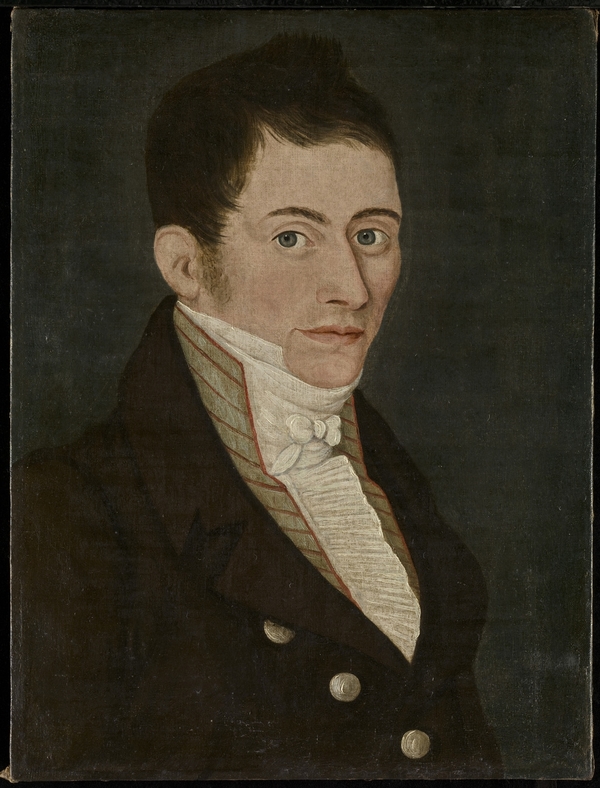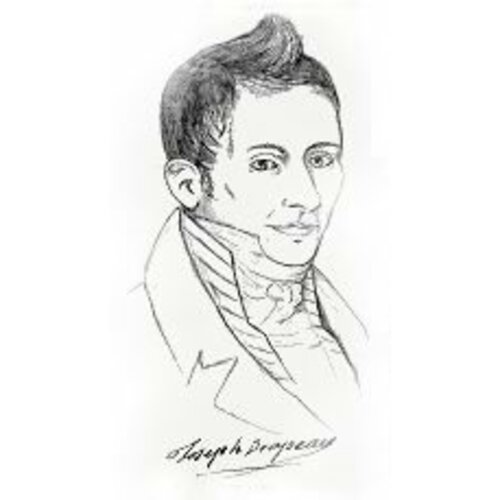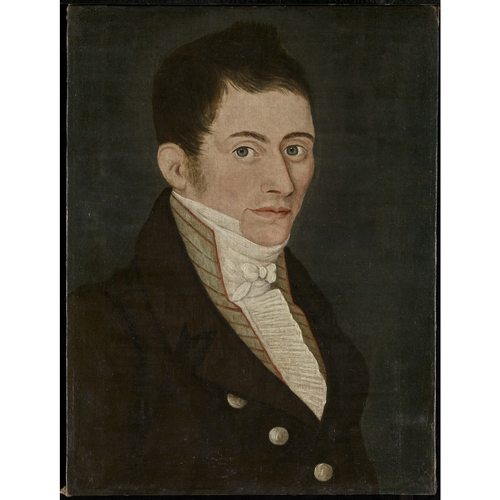
Source: Link
DRAPEAU, JOSEPH, merchant, seigneur, and politician; b. 13 April 1752 in Pointe-Lévy (Lauzon and Lévis, Que.), son of Pierre Drapeau, a farmer, and Marie-Joseph Huard, dit Désilets; m. 14 Oct. 1782 Marie-Geneviève Noël* in Saint-Antoine-de-Tilly, Que., and they had six daughters; d. 3 Nov. 1810 at Quebec, Lower Canada.
Although he was not destitute, Joseph Drapeau probably possessed little when he left Pointe-Lévy, where his father farmed 90 acres of land to keep his large family. He went to live at Quebec, probably early in the 1770s. He served in the militia during the American invasion of 1775–76 [see Benedict Arnold; Richard Montgomery*]. In April 1779 he obtained a permit to sell alcoholic beverages, and then two years later a hotel-keeper’s licence. At the time of his marriage he owned a house and a general store on the Place du Marché (Place Notre-Dame) in Lower Town, with an inventory evaluated at £1,066. His 16-year-old wife, the daughter of the seigneur of Tilly, Jean-Baptiste Noël, brought 4,000 livres to the joint estate. Because of the dearth of information on the early years of his career, however, it is impossible to know how he came to be a merchant or what conditions and means enabled him to set up his business.
Drapeau’s commercial operations rapidly spread beyond the limits of Lower Town. In 1788 he went into partnership with Louis Bourdages*, a merchant in Upper Town, who in return for capital undertook to sell at his store goods that Drapeau would furnish. Drapeau entered into a similar partnership in 1793 with Louis Bélair, a merchant in Baie-Saint-Paul, to whom he supplied imported and manufactured products in exchange for the surplus grain produced in the region. Their flourishing business even made necessary the purchase of a schooner, the Marie, which would ply between Quebec and Baie-Saint-Paul until 1804, when the commercial agreement came to an end.
In 1794 Drapeau negotiated the building of a ship in Louis Garennes’s shipyard on Île aux Grues. In March 1795 the sloop Saint-Pierre, commanded by Louis Bodoin, whom Drapeau had urged “to be active and as vigilant as he can . . . in order to make the aforesaid sailing as profitable as possible,” was carrying goods and passengers between the ports of Montreal, Quebec, Baie-Saint-Paul, and Rimouski.
In 1799 Drapeau owned his own shipbuilding yard in Baie-Saint-Paul. He personally hired the carpenters and caulkers, and he paid them four shillings a day for work “from sunrise to sunset, except for the time needed to take meals,” deducting from their wages “two days’ salary for each day lost.” In July the brig General Prescott left the shipyard. Drapeau, who was obtaining his supplies from British firms in business at Quebec, particularly those of John Blackwood and Adam Lymburner*, decided to trade directly with Europe. He fitted out the General Prescott to sail to Halifax, N.S., then to Liverpool, Bristol, and London, and from there to Lisbon. In November 1801 the 235-ton Denault left Baie-Saint-Paul for London where it was sold. The following year three schooners, the Marguerite, the Amelia, and the Marie, came off the stocks in his shipyard. The first was sold in 1802; the other two were used by Drapeau for his commerce until they were sold in 1808 and 1809. In 1803, at his quay on Rue du Sault-au-Matelot at Quebec, Drapeau had a schooner built which François Vassal* de Montviel and Jacques Voyer* bought that same year for £600. In 1805 Martin Chinic* purchased for £450 the schooner Clairet, which had been built at Quebec the previous year.
Like the other merchants and traders of the time Drapeau was induced to give credit to some of his clientele. Between 1780 and 1806 he held debts amounting to more than £5,000. The amounts due by note, ranging from £3 to £1,500 and payable at set dates, bore legal interest at 6 per cent. The debtors were mainly from the Quebec and Baie-Saint-Paul regions, but also from as far away as Rivière-Ouelle, Rimouski, Saint-Ours, Carleton, and Caraquet, N.B. Drapeau demanded solid guarantees. He did not hesitate to employ any legal recourse and thus to seize the property of debtors who were too slow in making repayment: an owner’s land, a skipper’s ship, and even rights of inheritance or widows’ claims to dower. He made use of all legal means, procurations or juridical proceedings, to obtain what was due him.
In 1784 Drapeau had begun to invest his profits in landed property. He paid £450 for a three-storey stone house on Rue de la Montagne that year. The following year he bought by tender before the Court of Common Pleas a lot fronting on the St Lawrence with a two-storey stone house and a quay. In 1797 he bought from James Tod three lots on Rue du Sault-au-Matelot. In 1803 the nuns of the Hôtel-Dieu of Quebec let him have a piece of land on the St Lawrence and another on the Riviére Saint-Charles.
Drapeau was a conscientious manager and applied himself to making his landed property turn a profit. In May 1795 he rented out for £17 a year the ground floor of the house in which he was living on the Place du March. He increased this rent to £42 the following year, then to £100 in 1805. He converted his house on Rue du Sault-au-Matelot into a bakery in 1797 and received five Spanish piastres a month for it, and £30 a year from 1798. He leased out the house he owned on Rue Saint-Pierre and received an annual rent of £45. His house on Rue de la Montague, which was rented for £27 a year, was leased in 1804 to hat-makers, who converted it into a shop and warehouse, paying £50 annually for it. The detailed leases stated precisely the condition of the buildings and the area allocated to the lessees in the sheds or stables. They described meticulously their obligations and set down exactly the terms of payment. Most often the lessees had to agree to specific demands upon them such as redoing the roof, repairing a wall that had been damaged, clearing the snow off the porches, digging a culvert, or even piling the cordwood in a precise spot in the yard. If they were behind in their payments, Drapeau cancelled the lease and found a new tenant.
Like many merchants Drapeau had his eye on the properties belonging to seigneurs. Within ten years he had accumulated large land holdings. In February 1789 he bought the seigneury of Champlain. In August of the following year he paid Simon Fraser and John Young £300 for the seigneury of Lessard, also called La Mollaie or Pointe-au-Père. That year as well he purchased the seigneury of Nicolas-Riou, known as Baie-du-Ha!Ha! At the same time he engaged in clever land transactions with René Lepage’s numerous heirs which made him the owner of four other seigneuries: Rimouski and Saint-Barnabé, Grand-Métis (Lepage, Thivierge, Anse-aux-Coques, Pointe-aux-Bouleaux, or Mitisses), Pachot or Rivière-Mitis, and Sainte-Claire. In 1791 and 1792 he made an arrangement with the owners of Rivière-du-Gouffre and became its titular seigneur. In August 1793, ill and fearful that he might leave his wife and daughters in “difficulties or misfortune through not being able, or not knowing how to develop and administer the aforesaid properties,” he sold almost all his landed property to Louis Bélair for £6,950. The next month, probably having recovered his health, he cancelled the sale. In December 1797 Drapeau parted with the seigneury of Champlain, selling it to Alexander Ellice for £525. The following year he reinvested his capital, buying half of the seigneury of Île d’Orléans. In 1805 Drapeau succeeded in acquiring a twelfth of the seigneuries of Rigaud-Vaudreuil, Gentilly, Perthuis, Beauvais, Rivière-Duchesne, and Sainte-Barbe-de-la-Famine, properties that belonged to Alexandre-André-Victor Chaussegros de Léry. He had, however, to let these lands go four years later when the seller’s brother, Louis-René Chaussegros* de Léry, exercised his right of lineal repurchase. He succeeded nevertheless in making £118 17s. on this transaction.
Drapeau rarely paid cash for his purchases. He preferred to arrange a bond or to make payment in the form of a life annuity or merchandise. He always managed to take advantage of seizures, sheriff’s sales, and auctions, thus obtaining cheaply properties that he resold at a profit.
Drapeau lost no time in rendering fealty and homage for the seigneury of Champlain in May 1789 and he began erecting a mill in June. Three years later he had a similar building put up at Rivière-du-Gouffre. He was much concerned with profits in these construction contracts, requiring guarantees of reliability, setting delivery dates, and even providing for penalties in the event he was not satisfied. When he leased out his mills at Baie-Saint-Paul, Rimouski, Rivière-du-Gouffre, or Île d’Orléans, he took care to describe their condition in detail and to have the millers’ obligations put in writing.
As soon as he had bought his properties, Drapeau the seigneur lost no time in taking inventory of them. In January and February 1791 the notary Alexandre Dumas issued in his name 54 new title deeds for land grants to tenants on the seigneury of Champlain. In the spring Dumas visited all the farms at Rimouski to give deeds for land grants, collect the cens et rentes, and draw up the register of landed property. The notaries Jean Néron and Barthélemy Faribault surveyed the seigneury of Rivière-du-Gouffre, drawing up new title deeds or leases à cens.
Drapeau did not hesitate to seize the farm of a tenant who was in debt and unable to pay the seigneurial dues, or to cancel a land sale if the seller had cheated him by lying about the size or condition of the buildings; he even interfered in the censitaires’ affairs, for example stipulating in a sale that the new purchaser could not “lease the above-mentioned piece of land to any persons practising the trade of tavern-keeper without express consent and permission in writing.” He advised his steward at Champlain, Joseph-Alexandre Raux, “to bring action through the competent court, both by personal judgement and condemnation and by seizure and distraint of their property” against tenants who were late in paying their dues. He entrusted the administration of his seigneuries to his brothers-in-law, Louis Bélair at Baie-Saint-Paul and Augustin Trudel at Rimouski.
Drapeau’s public life was uneventful and unmarked by scandal. In 1785, as a member of the merchant community, he supported Lieutenant Governor Henry Hamilton* when he was recalled to England. He was very concerned about the problems of education, and in 1787 joined in petitioning Lord Dorchester [Guy Carleton] to do everything in his power to ensure the reopening of the Jesuit college. In 1790 he became a member of the Fire Society and the Agriculture Society. The following year he joined the Canadian Militia of the Town and Banlieu of Quebec as an ensign, and in April signed a petition to the king favouring the remission of the lods et ventes. He indicated his loyalty to the British crown by joining an association formed in 1794 to support the constitution and government. Three years later he was a member of the jury of the Quebec Court of King’s Bench.
During the 1804 electoral campaign Drapeau attacked the candidate in the riding of Orléans, Jérôme Martineau, accusing him publicly of having extorted 40,000 livres from the Séminaire de Québec. When threatened with legal action he withdrew his charge and cleared Martineau’s reputation. In 1809 Drapeau ran in Northumberland riding. Elected on 23 November, he supported the Canadian party, voting in particular for the exclusion of judges from the assembly [see Sir James Henry Craig; Pierre-Amable De Bonne]. His political career, however, was brief, for he died on 3 November of the following year.
Since there are no records, little is known of Drapeau’s family life. He lived on the Place du Marché at first, and then from 1798 on Rue du Sault-au-Matelot. His household consisted of a servant or two and probably some slaves. His wife assisted in running his affairs, frequently accompanying him to the notary’s office to initial transactions. At times Drapeau behaved generously towards members of his family. He took in his invalid sister, paid for his brother Charles’s studies to become a notary, granted lands to his brothers and sisters, and had his daughters educated in the Ursuline convent. He was, however, parsimonious when it came to subscribing to causes. For example, he refused to contribute to the building of the church at Rimouski, and the habitants complained to Bishop Plessis*, who nevertheless took up his defence.
Drapeau was an intelligent businessman who invested in sectors of the economy that could earn him profits. He derived income from his business, interest on his loans, rents from his houses, dues from his seigneuries, and profits from his shipbuilding. He paid close attention to the management of his property, and it was probably through ability as much as parsimony that he succeeded in building the considerable fortune that his widow and daughters continued to manage after his death.
ANQ-Q, CE1-19, 13 avril 1752; CN1-26, 10 juin 1800; 23 févr., 6, 23 sept. 1803; 23 janv., 27 juill., 3 nov. 1804; CN1-63, 24 sept. 1810; CN1-83, 22 juill. 1786, 28 janv. 1789; CN1-92, 8, 16 mai 1788; 22 juin 1789; 17 août 1790; 6, 15 févr., 15–16 mai, 14 sept., 14 oct. 1791; 4 oct. 1792; 15 juin, 12 août 1793; 28 avril, 24 oct. 1794; 20 mars, 29 mai, 5 sept. 1795; 30 janv., 28 août 1797; 8 janv. 1798; 11 févr. 1799; 16 août 1800; CN1-99, 13–17 mai, 8 sept. 1797; 1er févr., 21 mars 1798; 28 août 1805; CN1-147, 6 juin 1804, 21 déc. 1805, 9 sept. 1806; CN1-178, 27 mai 1809, 8 juin 1810; CN1-224, 30 oct. 1782; CN1-230, 30 déc. 1797, 24 mai 1800, 22 mai 1805, 5 avril 1809; CN1-245, 4 juill. 1784; CN1-262, 23 sept. 1803; CN1-284, 12 déc. 1796; CN1-285, 1er oct. 1799; 5 févr., 27 oct. 1800; 17 nov. 1801; 24 juin 1802; CN4-16, 10–15 sept. 1792; P1000-32-592. PAC, MG 30, D56; RG 1, L3L: 37980–8083; RG 42, ser.1, 183: 11, 15, 34, 48, 57, 63, 68, 79, 91–92. Quebec Gazette, 29 April 1779; 17 May 1781; 20 June 1782; 28 Jan., 22 April 1790; 28 April 1791; 3 July 1794; 6 April 1797; 24 Jan. 1799; 7 June 1802; 8 Nov. 1810. Quebec almanac, 1791. F.-J. Audet, “Les législateurs du Bas-Canada.” Bouchette, Topographical description of L. C. Desjardins, Guide parl., 135. P.-G. Roy, Inv. concessions. J.-A. Lavoie, La famille Lavoie au Canada, de 1650 à 1921 (Québec, 1922). P.-G. Roy, L’île d’Orléans (Québec, 1928); Toutes petites choses du Régime anglais (2 sér., Québec, 1946). J. W. M., “Notes sur les seigneuries du district de Rimouski,” BRH, 17 (1911): 237–46, 257–67, 312–20, 331–38, 353–68. “Les seigneuries du négociant Drapeau,” BRH, 43 (1937): 81–82.
Cite This Article
Céline Cyr and Pierre Dufour, “DRAPEAU, JOSEPH,” in Dictionary of Canadian Biography, vol. 5, University of Toronto/Université Laval, 2003–, accessed April 10, 2025, https://www.biographi.ca/en/bio/drapeau_joseph_5E.html.
The citation above shows the format for footnotes and endnotes according to the Chicago manual of style (16th edition). Information to be used in other citation formats:
| Permalink: | https://www.biographi.ca/en/bio/drapeau_joseph_5E.html |
| Author of Article: | Céline Cyr and Pierre Dufour |
| Title of Article: | DRAPEAU, JOSEPH |
| Publication Name: | Dictionary of Canadian Biography, vol. 5 |
| Publisher: | University of Toronto/Université Laval |
| Year of revision: | 1983 |
| Access Date: | April 10, 2025 |




